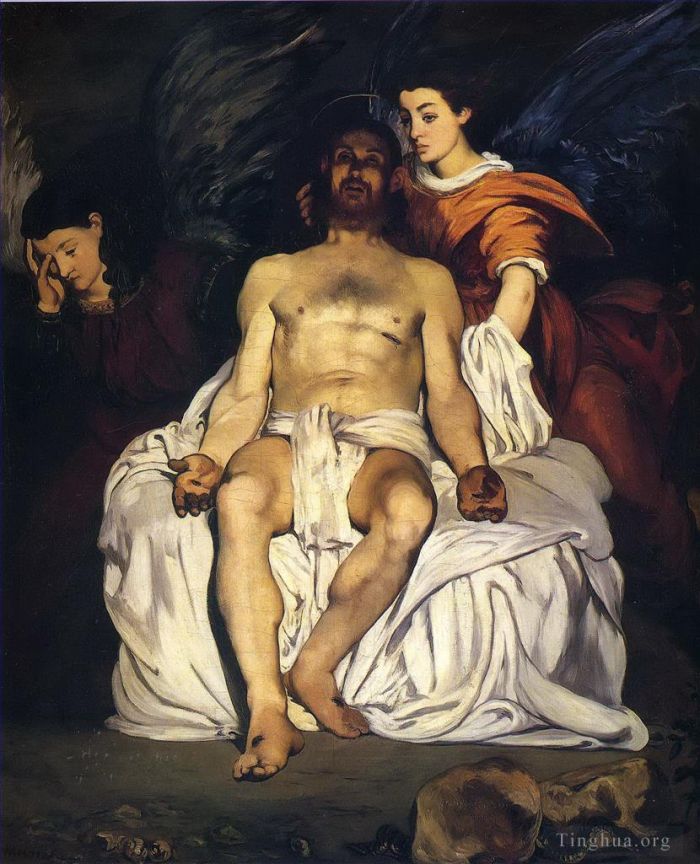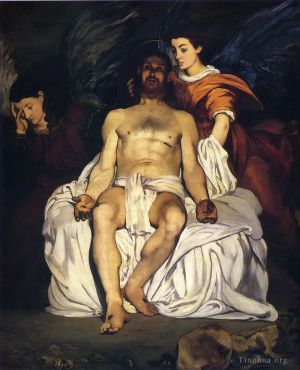The Dead Christ with Angels
Edouard Manet
- Price: Price on Request
- Art Type: Oil Painting
- Size:
- English Comments: 0
- International Comments: 0
- Creating Date:
- Introduction and Works of Edouard Manet >>
Work Overview
- The Dead Christ with Angels
Edouard Manet
Date: 1864; Paris, France *
Style: Realism
Genre: religious painting
Medium: Oil on canvas
Dimensions: 70 5/8 x 59 in. (179.4 x 149.9 cm)
Location: Metropolitan Museum of Art (Met), New York City, NY, US
Manet identified the source for this painting, the first of several religious scenes, in the inscription on the rock: the Gospel according to Saint John. However, in the passage cited, Christ’s tomb is empty except for two angels. After Manet sent the canvas to the 1864 Salon, he realized that he had made an even greater departure from the text, depicting Christ’s wound on the wrong side. Despite Charles Baudelaire’s warning that he would "give the malicious something to laugh at," the artist did not correct his mistake. Critics indeed denounced the picture, particularly the realism of Christ’s cadaverous body.
The Dead Christ with Angels, 1864 is one of the rare religious paintings by Manet and also one of the few produced in his period. Although he did not attach much importance to the subject of his paintings, Manet one day remarked to Antonin Proust, "There is one thing that I have always wanted to do, and that is to paint a crucifixion. Christ on the cross - what a wonderful symbol! You can go on searching until the end of time, but you will never find anything like it."
We do not know of any crucifixion by Manet, but he did paint this scene of Christ mourned by angels and also a Christ Scourged. The picture is painted in a somber tonality of funereal blacks and whites, set off, in the Spanish manner, by browns and blues.
"By the way," wrote Baudelaire to Manet when the picture was to be exhibited in April 1864, "it seems that the spear was driven into the right side. (Manet had painted the wound on the left.) You will have to change the place of the wound before the opening. Look it up in the Gospels and don't have malicious people making fun of you."
There was no lack, however, of malicious tongues to say that the painting was a pastiche of Francisco Goya and El Greco. Manet was accused of painting "dirt." Even Theophile Gautier wrote in Le Moniteur of June 25 that "in this figure of Christ the pallor of death is smudged by dirty black shadows."
But a new champion of Manet, Emile Zola, was particularly attracted by this work, in which he found more death than life. "Were are told that this Christ is not a Christ," he wrote in La Revue du XIXe siecle, "and I admit that may be so. As far as I am concerned it is a corpse, painted boldly and vigorously, with the light full on it. I even like the angels in the background - children with great blue wings."
The Dead Christ and the Angels was exhibited at the Salon of 1864 along with Incident in a Bullfight, which Manet later cut down to produce The Dead Toreador . These are the only two paintings on the subject of violent death Manet made prior to the Execution of Maximilian series. They were both completed during the period of the French intervention in Mexico and may contain veiled allusions to it. It is known that Manet began The Dead Christ and the Angels no sooner than November 1863, one month after Napoleon III began his campaign to place Maximilian on the Mexican throne.
This painting refers to a Biblical story in which Mary Magdalen, having been told that the body of the crucified Christ is missing, looks into his tomb and sees two angels sitting where His body once lay. She then turns to see the resurrected Christ standing behind her. Contrary to this narrative, Manet chose to portray Christ inside the tomb and in a liminal state between death and life, much as he pictured Maximilian calm and motionless in the final instant before he fell to the ground. In fact, newspaper reports of Maximilian’s death claimed that he likened the sacrifice of his own life to that of Christ.
- Copyright Statement:
All the reproduction of any forms about this work unauthorized by Singing Palette including images, texts and so on will be deemed to be violating the Copyright Laws.
To cite this webpage, please link back here.
- >> English Comments
- >> Chinese Comments
- >> French Comments
- >> German Comments
- >>Report
- Basket of Fruits
- The monk at prayer
- At Father Lathuille
- The Luncheon on the Grass (The Bath)
- The Grand Canal Venice
- Portrait of Emile Zola
- Portrait of Lina Campineanu
- Young Man in the Costume of a Majo
- The Bullfight
- Bench in autumn
- Victorine Meurent in the costume of an Espada
- Portrait of Zacharie Astruc
- Carnations and clematis in a crystal vase
- A boy with a pitcher
- Madame Brunet
- A matador
- On the Beach at Boulogne
- Reading Mme Manet and Leon
- Peaches
- The Kearsarge at Boulogne (Fishing boat coming in before the wind)
- Interior at Arcachon
- The ragpicker
- Woman in furs
- The model
- Madame Manet on a Blue Sofa
- Monet in his Studio Boat (Claude Monet Painting on His Boat-Studio in Argenteuil)
- Guitar and Hat
- The House at Rueil
- The Suicide
- Branch of White Peonies and Pruning Shears
- Jetty at Boulogne
- Portrait of Faure as Hamlet
- The Railway (Gare Saint-Lazare)
- Marguerite de Conflans Wearing Hood
- Theodore Duret
- Steamboat Leaving Boulogne
- Portrait of Gilbert Marcellin Desboutin
- Still Life Fruits on a Table
- The garden around Manet house
- Corner of a Café-Concert
- Boy with Dog
- Portrait of Mademoiselle Claus
- Young woman with a pink shoe
- Le Bon Bock A Good Glass of Beer
- Boy Blowing Bubbles
- Berthe Morisot with a Bouquet of Violets
- Portrait of Monsieur Brun
- Portrait of Emilie Ambre in the role of Carmen
- Effect of Snow at Petit Montrouge
- Vase of White Lilacs and Roses
- View of the 1867 Exposition Universelle
- Study of trees
- Moss Roses in a Vase
- Angelina
- Roses in a Champagne Glass
- Spring Study of Jeanne Demarsy
- The barque of Dante Copy after Delacroix
- The Street Singer
- Singer at a Cafe Concert
- Baudelaires Mistress Reclining Study of Jeanne Duval
- The Lemon
- Repose Study of
- A Game of Croquet
- Polichinelle
- Masked Ball at the Opera
- Bundle of Asparagus
- The Departure Of The Folkestone Boat
- The spanish ballet
- Argenteuil
- Plum
- At the Cafe
- Bench
- Gypsy with a Cigarette
- Rose and tulip
- Vase of Peonies on a Small Pedestal
- The Dead Christ with Angels
- Stephane Mallarme
- Nana
- Music in the Tuileries
- Christ with Angels
- Madame Manet in conservatory
- Swallows
- The Luncheon in the Studio
- Flowers in a Crystal Vase
- Madame Manet at the Piano
- Rochefort Escape
- The philosopher
- Still Life with Brioche
- Lola de Valence
- Bull fighting scene
- Portrait of Eva Gonzales
- Bouquet of flowers
- Eva Gonzales
- The Spanish Singer The Guitar Player
- Portrait of Mademoiselle Isabelle Lemonnier
- The Blonde with Bare Breasts
- The Waitress
- Woman with umbrella
- Young woman in the garden
- A Corner of the Garden in Rueil
- Madame Manet at Bellevue
- The Rest portrait of
- Woman Reading
- Bathers on the Seine
- Two Roses on a Tablecloth
- Le Chemin De Fer The Railroad
- The burial
- Execution of the Emperor Maximilian
- Embarkation after Folkestone
- Portrait of Henry Bernstein as a Child
- Head of a Dog
- The head of Christ
- Mother in the Garden at Bellevue
- Autumn Study of Mery Laurent
- The Races in the Bois de Boulogne
- Still life with melon and peaches
- Woman Before a Mirror
- Jesus Mocked by the Soldiers
- Flowers In A Crystal Vase flower Impressionism Edouard Manet
- The Port of Bordeaux
- A brioche
- Rue Mosnier decorated with Flags
- The Banks of the Seine at Argenteuil
- Lilac in a glass
- Woman Pouring Water Study of Suzanne Leenhoff
- The Monet family in their garden at Argenteuil
- View of Holland
- Portrait of Antonin Proust Realism Impressionism Edouard Manet
- Boating
- A King Charles Spanie
- Peonies in a vase
- The Horsewoman
- M and Mme Auguste Manet
- The conservatory
- Woman in a Tub
- A young man peeling a pear
- The Jetty at Boulogne
- Interior of a Cafe
- The ham
- On The Beach
- Pertuiset Lion Hunter
- The grand canal of Venice
- Oysters
- The Execution of the Emperor Maximilian of Mexico
- In the garden
- Portrait of Antonin Proust
- Victorine Meurent
- Young woman with a book
- Tarring the Boat
- Young woman in a round hat
- The Races at Longchamp
- The Milliner
- At the races
- The absinthe drinker
- Olympia
- Seascape at Berck Fishing Boats and Fishermen
- The old musician
- The Balcony
- Fishing
- Madame Auguste Manet
- The Boy with Cherries
- The Fifer
- Women at the Races
- Portrait of Suzanne Manet
- Surprised Nymph
- Portrait of Monsieur Tillet
- Almonds currants and peaches
- The stroll
- Young Woman in Oriental Garb
- Battle of Kearsage and Alabama
- The road menders Rue de Berne
- Woman with a Parrot
- Boy with a sword
- Eel and Red Mullet
- Woman with Fans (The Lady with Fans or Portrait of Nina de Callias)
- The Café-Concert (At the Café or The Bock Drinkers)
- The salmon
- Seascape at Arcachon
- The Garden at Bellevue
- The dead toreador
- Young Woman Reclining in Spanish Costume
- Young woman among the flowers
- Woman fastening her garter
- A Bar at the Folies-Bergère
- Bouquet Of Violets still life Impressionism Edouard Manet
- The Port of Bordeaux 2
- Head Of A Man
- Young woman in a negligee
- Portrait Of Mme Jules Guillemet
- On the Bench
- The Barricade Civil War









 Singing Palette
Singing Palette